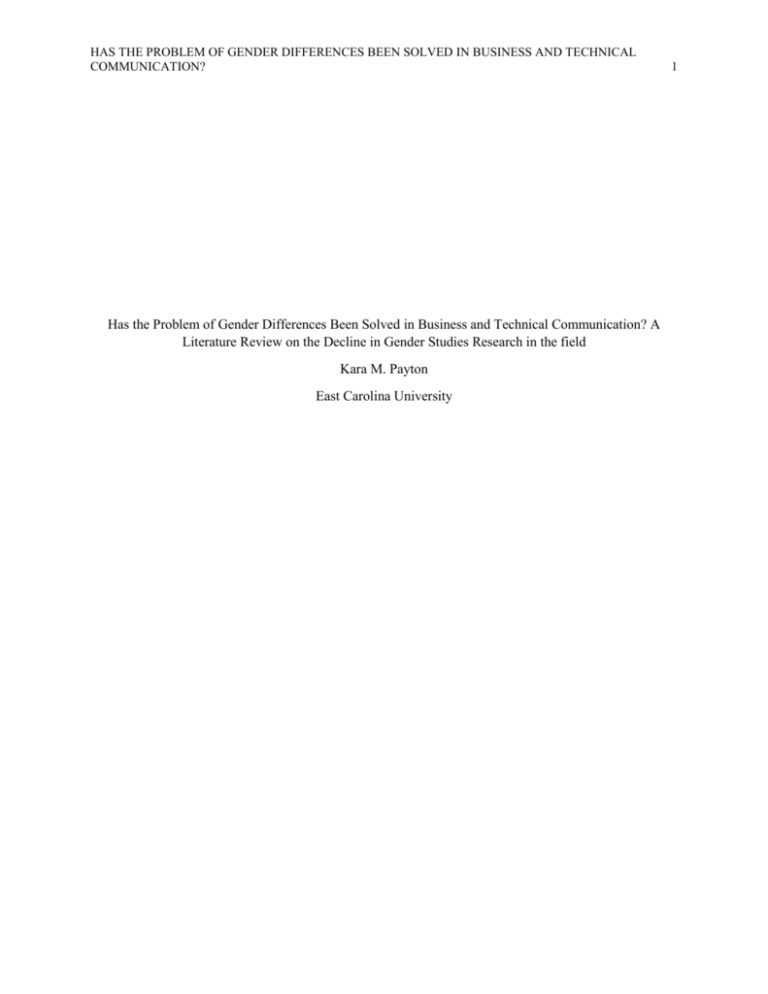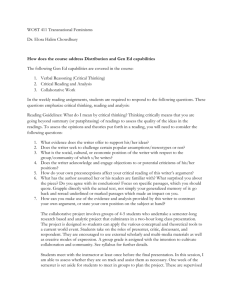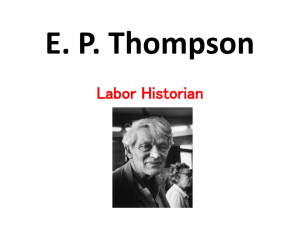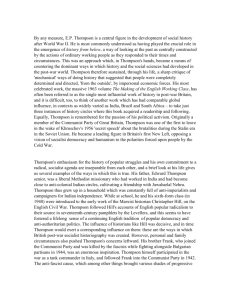Paytoneng6702literaturereviewgetto
advertisement

HAS THE PROBLEM OF GENDER DIFFERENCES BEEN SOLVED IN BUSINESS AND TECHNICAL COMMUNICATION? Has the Problem of Gender Differences Been Solved in Business and Technical Communication? A Literature Review on the Decline in Gender Studies Research in the field Kara M. Payton East Carolina University 1 HAS THE PROBLEM OF GENDER DIFFERENCES BEEN SOLVED IN BUSINESS AND TECHNICAL COMMUNICATION? 2 Kara Payton English 6702 Dr. Getto Literature Review September 27,2015 Introduction In the past, researchers have focused on women in technical communication. Thompson and Smith (2006) and Thompson (1999) conducted studies on technical communication journals to review the latest feminist research in technical communication. According to Thompson and Smith (2006), much of the current gender research is outside of the technical communication realm. White et Al., female scholars and English professors at Purdue University (2015) call for more feminist research in their maledominated classrooms that “average only 1 female student per class of 22. It is all too easy in such classrooms for us to perpetuate the myth that there are no longer issues of gender because the supposed gender-neutral environment of technology and business writing classrooms is still male, the students are all male, the textbooks are male, and the writing models are male”. According to Thompson (2006), over the last fifteen years, research has declined in feminist technical communication. While there are studies being done today, are they really affecting the “gender-neutral” classrooms and workplaces in technical communication? The original gender difference research began with Mary Lay’s award-wining feminist study in 1989. Award Winning Study on Collaborative Writing and Gender In 1989, Mary Lay did a groundbreaking study on collaborative writing and how men and women differ in their approach to interpersonal conflict in the classroom. In groups, women resort to selfdisclosure for trust and men enjoy individual competition. Lay (1989) calls for technical communication professors to monitor small-group behavior using journaling and grade incentives. She advocated HAS THE PROBLEM OF GENDER DIFFERENCES BEEN SOLVED IN BUSINESS AND TECHNICAL COMMUNICATION? 3 androgynous communication skills, blending men’s and women’s styles of communication. According to Thompson (1999), only two later studies supported her claims of gender differences in communication styles. Since the 1989 study, the current research on gender differences contradicts her conclusions about communication differences between men and women. The research in this area has been largely dropped, with the main research problem apparently solved. Women and Feminism in Technical Communication 1989-1997 Isabelle Thompson (1999) conducted a study surveying forty articles on women and feminism published in five technical communication journals over a period of nine years. The study used qualitative content analysis, which is “a technique used to identify and describe patterns in a collection of texts”. To narrow the 1072 texts, she searched for certain key words in the titles of the journal articles, such as “female, feminist, gender, gendered, cross-gender, gender-neutral, sexual, sexes, sexism, sexist and women”. The narrowed group of forty articles all shared a common theme of “women’s’ inclusion, moderate or radical change in technical communication research and practice”. According to Thompson (1999), Lay’s call for androgyny has been heard: “Men and women were both using tentative language, they interrupted each other equally, and they used full range of collaborative approaches”. This study found gender differences was a hot topic of research, but did not produce the answers researchers anticipated. Also during this time, studies on the history of women in technical communication became popular, with researchers like David Carrell’s 1991 analysis of textbooks published post World War II concluded that the textbooks perpetuated traditional women’s stereotypes. Thompson (1999) concluded “while research on gender differences has stalled, historical studies have made significant contributions to redefining what Lay called for in 1991…Historical studies have led to a broadened view of what constitutes a technical document and who can write one”. Thompson (1999) calls for further research regarding women, maybe “a collection of stories by women about their development of workplace literacy”. HAS THE PROBLEM OF GENDER DIFFERENCES BEEN SOLVED IN BUSINESS AND TECHNICAL COMMUNICATION? 4 Later Research Themes in Journal Articles on Gender and Technical Communication 1998-mid-2004 After the original research study overview by Thompson (1999), Thompson and Smith (2006) did a later study continuing the feminism overview in later years. They concluded that the journal topics covered masculine bias in written texts, gender differences, recovery of women’s contributions, and critiques of representations of women and representations that exclude women. Interestingly, the studies conducted on gender difference concluded that “most of these articles have been reviewed in our 2002 article, which concludes that, regardless of how hard researchers try, few differences in the communicative collaborative styles of men and women have been found”. According to Thompson (2006), once women and men work together, the differences in communication disappear once they are into the workplace culture. Technical communication researchers pieced together lost women’s history from the Renaissance to the early nineteenth century, giving credence to early women science writers, scientists and technical writers. The topic of masculine bias in written texts found women as domestic and identified with the home. In taking into account historical women technical communicators, Thompson and Smith (2006) call for definitions of technology to be redefined include contributions of these women. Psychological Study on Gender and Learning Technology Outside of the technical communication research realm, Hwang et al (2009) did a psychological study about middle school children and the girls’ lack of motivation to learn technology. The study pointed to family relations and societies’ expectations of the girls and their motivation to learn. The study concluded that it was an attitude difference that led to girls choosing to shirk technology and those scientific careers. The study called for more research on females and technology, since much previous research has been done on girls and math. HAS THE PROBLEM OF GENDER DIFFERENCES BEEN SOLVED IN BUSINESS AND TECHNICAL COMMUNICATION? 5 Media Perpetuating Gender Stereotypes in Scientific Neurobiology Study on Biological Brain Structure Differences Between Men and Women An interesting study that tracked media influence and gender stereotypes in scientific reporting by O’Connor and Joffe (2014) touted men and women’s brain structure differences. The study conducted involved the brains of 949 individuals aged between 8-22 years. Males showed greater withinhemisphere-connectivity and females showed greater between-hemisphere connectivity in all regions except the cerebellum. The study showed that men and women had different areas of specialization. But the study was a ruse. Just as the researchers imagined, the study’s results sparked a media frenzy that skewed its results and perpetuated the male-female stereotypes. Conclusion Since Mary Lay’s 1989 foundational study, the lag in gender difference research is really good news. If there are differences, either women have adapted or their environments have evolved. The past studies did not have the effect of changing classroom or workplace environments to include gender education. Is it because they have answered the questions about gender differences in their previous research? On the other hand, gender difference is only one area of feminist studies in technical communication. While fewer feminist studies occur today, newer questions have to be asked to develop a call for more research. According to White et al. (2015), “we are disturbed to find that very little seems to have changed in the past 25 years. We were surprised and dismayed not at what we found in textbooks and professional journals, but what we didn’t find... Unfortunately, based on our analysis of professional academic journals and current textbooks in business and technical communication, the discourse seems to paint a false picture of the workplace as neutral and non-gendered. The reality within our classrooms is equally uneven and highly gendered as well.” What about usability studies and women? Although there was a study by Vanzo et al (2015) on targeting product assembly instructions to women, how about more research to help technical communicators target to women, the largest buyer of household goods? How HAS THE PROBLEM OF GENDER DIFFERENCES BEEN SOLVED IN BUSINESS AND TECHNICAL COMMUNICATION? about pay differences and barriers to entrance in the field of technical communication? What about technology use and women’s motivation to learn? While a few studies in these areas have been completed, much more research can be done on feminist studies and women in the technical communication field. 6 HAS THE PROBLEM OF GENDER DIFFERENCES BEEN SOLVED IN BUSINESS AND TECHNICAL COMMUNICATION? 7 References Carrell, David. (1991, October). Gender Scripts in Professional Writing Textbooks. Journal of Business and Technical Communication. Vol 5 No. 4 463-468. Hwang, Young Suk, Fisher, William, Vrongistinos, Konstantinos. (2009). Calibrating a Measure of Gender Differences in Motivation for Learning Technology. Journal of Instructional Psychology, 36(3). Lay, Mary M. (1989, September). Interpersonal Conflict in Collaborative Writing: What We Can Learn From Gender Studies. Journal of Business and Technical Communication, Vol 3, No. 2, 5-28. O’Connor, Cliodhna, Joffe, Helene. (2014). Gender on the Brain: A Case Study of Science Communication in the New Media Environment, retrieved online from ProQuest. Thompson, Isabelle, Overman, Elizabeth. (2006). Women and Feminism in Technical Communication— An Update. Journal of Technical Writing and Communication, Vol 36(2), 183-199. Thompson, Isabelle. (1999). Women and Feminism in Technical Communication: A Qualitative Content Analysis of Journal Articles Published in 1989 through 1997. Journal of Business and Technical Communication, 13(2), 154-178. Retrieved from ProQuest Online. Vanzo, Roher Valentina, Stern, Tobias, Pocnocny-Selinger, Elizabeth, Schwarzbauer, Peter (2015). Technical Communication in Assembly Instructions: An Empirical Study to Bridge the Gap Between Theoretical Gender Differences and Their Practical Influence. Journal of Business and Technical Communication, 1-30. White, Kate, Rumsey-Kesler Suzanne, Stevens, Amidon. (2015). Are We “There” Yet? The Treatment of Gender and Feminism in Technical, Business, and Workplace Writing Studies. Journal of Technical Writing and Communication, Retrieved from jtw.sagepub.com September 18, 2015.










